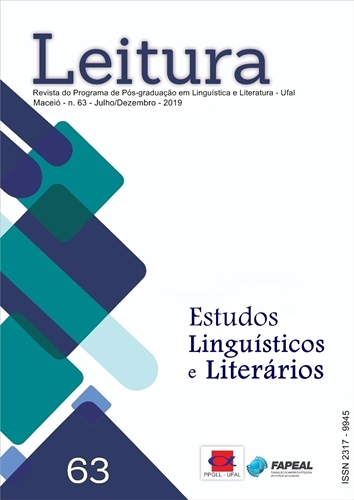Sinais bimanuais da Libras: um estudo da produção de sinais realizados no subespaço “costas da mão” do parâmetro locação
DOI:
https://doi.org/10.28998/2317-9945.201963.106-119Palavras-chave:
Alofone. Costas da mão. Locação. Mão de apoio. Variação fonológicaResumo
O objetivo deste artigo foi realizar uma análise de como se apresentam os sinais da Língua Brasileira de Sinais (Libras) pelos sinalizadores surdos de Sergipe, produzidos com as duas mãos, em que a mão ativa configura o sinal e a passiva serve de apoio para o sinal configurado, no subespaço “costas da mão”, da locação “mão de apoio”. Esse estudo teve como metodologia a pesquisa bibliográfica, utilizando como principais bases teóricas os estudos linguísticos de Quadros e Karnopp (2004), Felipe (1998), Brito (1998) e Karnopp (1999), e a pesquisa de campo, por meio da observação direta da sinalização dos participantes e do vídeo-registro das variantes que ocorrem na forma como se apresenta o subespaço “costas da mão”, da locação mão de apoio, na produção dos sinais, identificando se a frequência é maior na forma de mão aberta ou fechada. Os resultados encontrados nesta pesquisa nos levaram a uma análise de que as variações que ocorrem na forma da mão do subespaço “costas da mão” quando um sinal é produzido sobre ela podem se caracterizar como um alofone, uma vez que essas variações não alteram o sentido nem o significado dos sinais.
Libras’ bimanual signs: a study regarding the production of signs realized in the subspace “back of the hand” of the location parameter
The aim of this article was to perform an analysis of how the signs of the Brazilian Sign Language (Libras), produced with two hands, in which the active hand configures the sign and the passive one works as a support for the configured sign, in the subspace “back of the hand”, of the location “hand of support”, are used by the deaf people from Sergipe. The methodology of this study is the bibliographic research, using as main theoretical framework the linguistic studies by Quadros and Karnopp (2004), Felipe (1998), Brito (1998) and Karnopp (1999), and the field research, using the direct observation of the participants signing and the video-recording of the variants that occur in the way the subspace “back of the hand”, of the hand support location, is presented in the production of the signs, in order to identify if the frequency is greater in the form of hand open or closed. The results found in this research led us to conclude that the variations that take place in the form of the hand of the subspace “back of the hand”, when a sign is produced on it, can be characterized as an allophone, since these variations do not alter the sense and meaning of the signs.
Keywords: Back of the hand. Location. Support hand. Phonological variation










